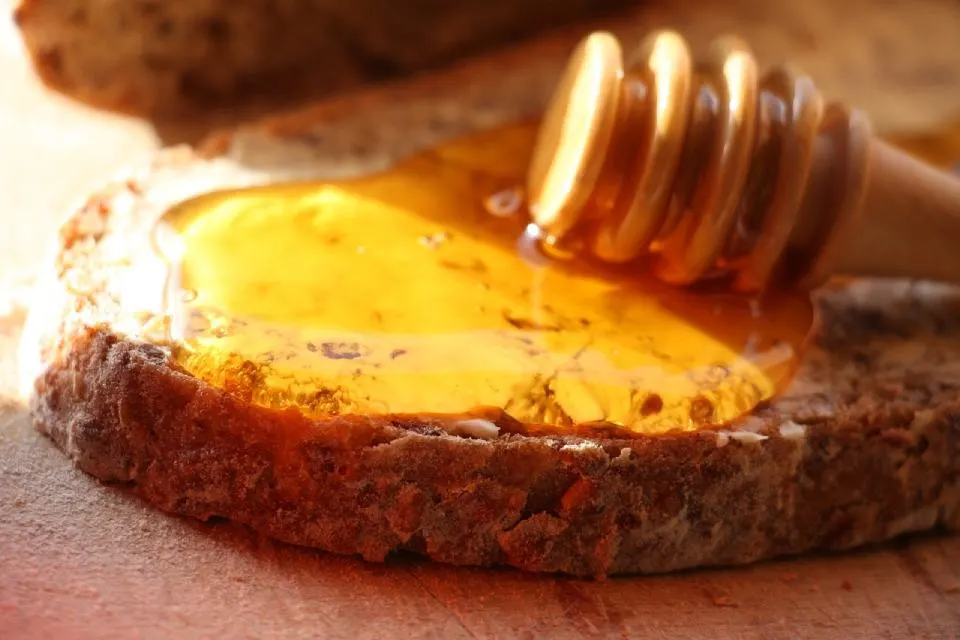
Struggling to find that perfect balance between delectable taste and nutritional value in your bread? You’re not alone. Many of us yearn for a bread recipe that doesn’t just serve as a bland vehicle for our sandwiches but stands out with its own rich flavors and health benefits. Enter the honey wheat bread – a delightful concoction that marries the wholesome goodness of whole wheat with the natural sweetness of honey.
TL;DR
- 67% of Americans prefer whole grains, making honey wheat bread a popular choice.
- Honey wheat bread is packed with fiber and nutrients, outshining white bread.
- The natural sweetness and preservative qualities of honey enhance the bread’s taste and shelf life.
- Martha Stewart praises honey wheat bread for its health benefits without compromising taste.
- This recipe offers a simple, step-by-step guide to baking your own delicious loaves at home.
The Rise of Whole Grains in America
With an impressive 67% of Americans now opting for whole grains for at least half of their grain intake, the shift towards healthier bread options is unmistakable. Leading this health-conscious charge is the ever-popular honey wheat bread, a delightful combination of whole wheat’s hearty nuttiness and the gentle sweetness of honey. This bread transcends mere taste pleasure, offering a fiber-rich, nutrient-dense contribution to a well-rounded diet.
Why Honey Wheat Bread?
Honey wheat bread has emerged as a beloved staple in many health-conscious households, distinguishing itself from traditional white bread through its superior nutritional value and unique flavor profile. This section delves into the reasons behind its popularity, focusing on its ingredients and health benefits.
The Whole Wheat Advantage
The primary ingredient that sets honey wheat bread apart is whole wheat flour. Unlike refined white flour, whole wheat flour retains all parts of the grain kernel, including the bran, germ, and endosperm. This means it’s not only richer in dietary fiber but also teems with essential nutrients. Fiber is crucial for maintaining digestive health, aiding in regular bowel movements, and contributing to a feeling of fullness, which can help in weight management. Moreover, whole wheat flour is a significant source of B vitamins, which play a vital role in energy metabolism, and minerals like iron, magnesium, and zinc, which are vital for various bodily functions.

The Sweet Touch of Honey
Honey, the natural sweetener in honey wheat bread, offers more than just a hint of sweetness. Its inclusion in the bread recipe brings a unique flavor that complements the nuttiness of whole wheat, making the bread appealing to both adults and children. Beyond taste, honey acts as a natural preservative due to its antibacterial properties, which can help extend the shelf life of the bread. This makes honey wheat bread not only a healthier option but also a more convenient one, staying fresh for longer periods compared to conventional bread.
Nutritional Synergy
The combination of whole wheat flour and honey creates a nutritional synergy in honey wheat bread. The complex carbohydrates and fiber from the whole wheat provide sustained energy and satiety, while the natural sugars in honey offer a quick energy boost without the spike and crash associated with refined sugars. Additionally, the antioxidants present in both whole wheat and honey contribute to the bread’s health benefits, offering protection against oxidative stress and inflammation.
Honey Wheat Bread Recipe
Perfect for your morning toast or a hearty sandwich, this honey wheat bread is about to become your new homemade favorite. Let’s dive in and fill your home with the warm, comforting aroma of freshly baked bread.
Ingredients:
- 1 1/2 cups warm water (about 110°F or 43°C)
- 2 tablespoons honey (local honey preferred for its rich flavor)
- 2 1/4 teaspoons active dry yeast (1 packet)
- 2 cups whole wheat flour
- 1 1/2 – 2 cups all-purpose flour
- 1/4 cup olive oil or melted unsalted butter
- 1 teaspoon salt
Instructions:
- Yeast Activation:
- In a large mixing bowl, dissolve the honey in warm water. Sprinkle the yeast over the top and let it sit for about 5 minutes, or until the mixture is frothy. This step is crucial for activating the yeast.
- Mixing the Dough:
- To the yeast mixture, add the whole wheat flour, 1 1/2 cups of all-purpose flour, olive oil (or melted butter), and salt. Stir until the mixture starts to form a dough.
- Kneading:
- Turn the dough out onto a floured surface and knead, gradually adding the remaining all-purpose flour as needed, until the dough is smooth and elastic, about 8-10 minutes.
- First Rise:
- Place the kneaded dough in a greased bowl, turning once to coat. Cover with a clean kitchen towel and let it rise in a warm, draft-free area until doubled in size, about 1-2 hours.
- Shaping:
- Once risen, punch down the dough gently and turn it out onto a lightly floured surface. Shape it into a loaf and place it in a greased 9×5 inch loaf pan.
- Second Rise:
- Cover the loaf pan with a towel and let the dough rise again until it’s about 1 inch above the pan, approximately 30-45 minutes.
- Baking:
- Preheat your oven to 375°F (190°C). Once the dough has risen, bake it in the preheated oven for 25-30 minutes, or until the top is golden brown and the loaf sounds hollow when tapped.
- Cooling:
- Remove the bread from the oven and let it cool in the pan for 10 minutes. Then, turn it out onto a wire rack to cool completely.
Tips for Success:
- Quality Ingredients: Using high-quality, organic whole wheat flour and local honey can significantly enhance the flavor of your bread.
- Temperature Control: Ensure your water is at the right temperature for yeast activation; too hot or too cold can affect the rise of your bread.
- Patience is Key: Allow your bread to fully rise during both the first and second rises. Rushing this process can result in a denser loaf.
Martha Stewart’s Seal of Approval
Even culinary experts recognize the allure of honey wheat bread. Martha Stewart, a household name in home cooking and baking, once said, “Honey wheat bread combines the wholesome goodness of whole grains with a touch of sweetness from honey. It’s an excellent choice for those looking to make healthier dietary choices without sacrificing taste.” This endorsement underscores the bread’s appeal to both health-conscious individuals and those with a sweet tooth.
Baking Your Own Honey Wheat Bread
Imagine the aroma of freshly baked bread wafting through your kitchen, a scent so inviting it feels like a warm hug. Baking honey wheat bread at home is simpler than you might think, and the rewards are plentiful. Not only do you get to control the quality of ingredients, but you also partake in the therapeutic process of bread-making, from kneading the dough to watching it rise and transform in the oven.
Insider Tips for the Perfect Loaf
Crafting the perfect loaf of honey wheat bread is an art that combines the science of baking with the warmth of home cooking. As a seasoned journalist in the realm of honey wheat bread recipes, I’ve had the privilege of learning from numerous bakers and chefs. Through this journey, I’ve collected invaluable tips that can transform your baking experience and elevate your bread to new heights of flavor and texture. Here’s a guide to ensuring your honey wheat bread is nothing short of perfection every time you bake.
Selecting the Right Ingredients
The Foundation – Whole Wheat Flour: The choice of flour can make a significant difference in your bread. Opt for high-quality, organic whole wheat flour. Organic flours often have a better flavor profile and contain fewer additives, ensuring your bread is not only delicious but also as healthy as possible. The richness and texture of whole wheat flour add depth to your bread, making it both tastier and more nutritious.
The Sweet Touch – Local Honey: Honey is the heart of this bread, providing a subtle sweetness and a moist texture. Using local honey not only supports local businesses but also ensures your bread has a unique flavor characteristic of your area’s flora. Local honey can introduce a range of subtle flavors, from floral to slightly fruity, depending on the flowers the bees have pollinated.
Mastering the Temperature
Yeast Activation – The Warmth Factor: Yeast is a living organism that requires just the right environment to thrive. The temperature of the liquids you add to your dough is crucial. Too hot, and you risk killing the yeast; too cold, and it won’t activate properly. Aim for a liquid temperature of about 110°F (43°C) – warm to the touch but not hot. This optimal temperature will encourage the yeast to bloom and contribute to a well-risen loaf.
Embracing the Art of Patience
The Rise – A Test of Time: One of the most common mistakes in bread baking is impatience during the rising process. Rushing this step can lead to dense, underwhelming loaves. Allow your dough to rise in a warm, draft-free area until it’s doubled in size. This process can take anywhere from 1 to 2 hours, depending on the temperature and humidity of your environment. Remember, the yeast is working its magic during this time, developing flavors and textures that will make your bread truly special.
Second Rise – Building Structure: After shaping your loaf, a second rise (or proofing) is essential. This step allows the gluten structure to strengthen and the yeast to continue fermenting, contributing to the bread’s final texture and volume. This second rise is often shorter than the first but equally important.
Conclusion
In conclusion, honey wheat bread represents a harmonious blend of taste and nutrition, setting itself apart from conventional bread options. With its foundation of whole wheat flour, this bread is a treasure trove of dietary fiber and essential nutrients, promoting digestive health and sustained energy. The addition of honey not only imparts a delightful sweetness but also serves as a natural preservative, enhancing the bread’s freshness and shelf life. Baking honey wheat bread at home elevates the experience, transforming it into a rewarding and therapeutic endeavor. It allows for a personal touch in selecting quality ingredients and the satisfaction of witnessing the magical transformation of simple components into a warm, aromatic loaf.
The process, enriched with insider tips like optimal yeast activation and patient dough rising, ensures a successful bake even for beginners. Honey wheat bread is more than just food; it’s a testament to the joy of baking and the possibility of integrating wholesome, delicious options into our daily diet. This bread is not just a healthy alternative but a celebration of flavor, making it a cherished choice for those seeking to nourish both body and spirit.
FAQs
What makes honey wheat bread healthier than white bread?
Honey wheat bread is richer in fiber and nutrients due to the whole wheat flour, and the addition of honey provides natural sweetness and preservative benefits.
Can I use honey wheat bread for sandwiches?
Absolutely! Honey wheat bread is versatile and perfect for both sweet and savory sandwiches.
How long does homemade honey wheat bread last?
When stored properly, homemade honey wheat bread can last up to 4-5 days at room temperature or longer if refrigerated.
Is honey wheat bread suitable for beginners?
Yes, with the right recipe and some patience, even baking novices can create delicious honey wheat bread.
Can I freeze honey wheat bread?
Yes, honey wheat bread freezes well. Wrap it tightly to prevent freezer burn and enjoy it for up to 3 months.
Join Us and Transform >
Don’t Be an Amateur! Master the Art of Sourdough Bread!




Leave a comment